Galindo, J.; Dolz, V.; Monsalve-Serrano, J.; Bernal-Maldonado, MA.; Odillard, L. (2021). Impacts of the exhaust gas recirculation (EGR) combined with the regeneration mode in a compression ignition diesel engine operating at cold conditions. International Journal of Engine Research. 22(12):3548-3557. https://doi.org/10.1177/14680874211013986
Por favor, use este identificador para citar o enlazar este ítem: http://hdl.handle.net/10251/186847
|
Título:
|
Impacts of the exhaust gas recirculation (EGR) combined with the regeneration mode in a compression ignition diesel engine operating at cold conditions
|
|
Autor:
|

 Galindo, José
Galindo, José

 Dolz, Vicente
Dolz, Vicente

 Monsalve-Serrano, Javier
Bernal-Maldonado, Miguel Angel
Odillard, Laurent
Monsalve-Serrano, Javier
Bernal-Maldonado, Miguel Angel
Odillard, Laurent
|
|
Entidad UPV:
|
Universitat Politècnica de València. Departamento de Máquinas y Motores Térmicos - Departament de Màquines i Motors Tèrmics
|
|
Fecha difusión:
|
|
|
Resumen:
|
[EN] Internal combustion engines working at cold conditions lead to the production of excessive pollutant emissions levels. The use of the exhaust gas recirculation could be necessary to reduce the nitrogen oxides emissions, ...[+]
[EN] Internal combustion engines working at cold conditions lead to the production of excessive pollutant emissions levels. The use of the exhaust gas recirculation could be necessary to reduce the nitrogen oxides emissions, even at these conditions. This paper evaluates the impact of using the high-pressure exhaust gas recirculation strategy while the diesel particulate filter is under active regeneration mode on a Euro 6 turbocharged diesel engine running at low ambient temperature (-7 degrees C). This strategy is evaluated under 40 h of operation, 20 of them using the two systems in combination. The results show that the activation of the high-pressure exhaust gas recirculation during the particulate filter regeneration process leads to a 50% nitrogen oxides emissions reduction with respect to a reference case without exhaust gas recirculation. Moreover, the modification of some engine parameters compared to the base calibration, as the exhaust gas recirculation rate, the main fuel injection timing and the post injection quantity, allows to optimize this strategy by reducing the carbon monoxide emissions up to 60%. Regarding the hydrocarbons emissions and fuel consumption, a small advantage could be observed using this strategy. However, the activation of the high-pressure exhaust gas recirculation at low temperatures can produce fouling deposits and condensation on the engine components (valve, cooler, intake manifold, etc.) and can contribute to reach saturation conditions on the particulate filter. For these reasons, the regeneration efficiency is followed during the experiments through the filter status, concluding that the use of low high-pressure exhaust gas recirculation rates in combination with the regeneration mode also allows to clean the soot particles of the particulate filter. These soot depositions are visualized and presented at the end of this work with a brief analysis of the soot characteristics and a quantitative estimation of the total soot volume produced during the experimental campaign.
[-]
|
|
Palabras clave:
|
DPF Regeneration
,
EGR
,
Cold conditions
,
NOx reduction
,
Emissions reduction
|
|
Derechos de uso:
|
Reserva de todos los derechos
|
|
Fuente:
|
International Journal of Engine Research. (issn:
1468-0874
)
|
|
DOI:
|
10.1177/14680874211013986
|
|
Editorial:
|
SAGE Publications
|
|
Versión del editor:
|
https://doi.org/10.1177/14680874211013986
|
|
Código del Proyecto:
|
info:eu-repo/grantAgreement/UPV//PAID-01-17//Contratos Pre-Doctorales UPV 2017- Subprograma 1/
|
|
Descripción:
|
This is the author's version of a work that was accepted for publication in International Journal of Engine Research. Changes resulting from the publishing process, such as peer review, editing, corrections, structural formatting,
and other quality control mechanisms may not be reflected in this document. Changes may have been made to this work since it was submitted for publication. A definitive version was subsequently published as https://doi.org/10.1177/14680874211013986
|
|
Agradecimientos:
|
The author(s) disclosed receipt of the following financial support for the research, authorship, and/or publication of this article: Authors want to acknowledge the support of "Programa de Ayudas de Investigacion y Desarrollo ...[+]
The author(s) disclosed receipt of the following financial support for the research, authorship, and/or publication of this article: Authors want to acknowledge the support of "Programa de Ayudas de Investigacion y Desarrollo (PAID-01-17) de la Universitat Politecnica de Valencia.''
[-]
|
|
Tipo:
|
Artículo
|







![[Cerrado]](/themes/UPV/images/candado.png)


